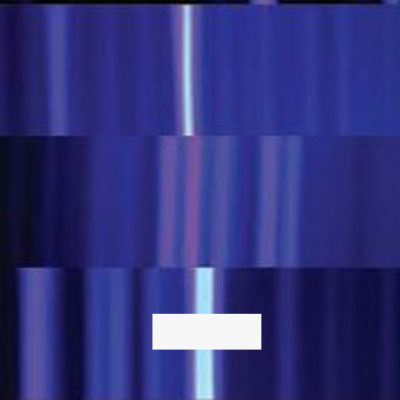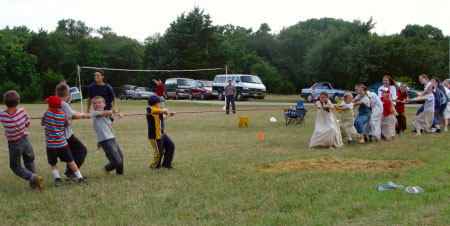Chapter 10. The Scale and Motion of the Earth-Moon System
10.1 Introduction

Author: Jordan Raddick, Johns Hopkins University
Editor: Beth Hufnagel, Anne Arundel Community College
The goals of this module: At the end, you should be able to:
- Identify and compare the relative sizes of the Earth and the Moon.
- Show how distance between the Earth and the Moon compares to the sizes of both bodies.
- Relate Newton's First and Second Laws of Motion to the Earth-Moon System.
- Explain how the Moon's rotation results in only one side being visible from the Earth.
In this module you will explore:
- A scale model of the sizes of the Earth and the Moon, and the distance between them.
- How the Moon and the Earth orbit around their common center of mass.
Why you are doing it: The Moon is the nearest and most familiar object in the sky, but the fact that we are so familiar with it means that it is easy to overlook what it is really like, and how the Moon relates to the Earth as a planet.
10.2 Background

The Moon is our closest neighbor in the universe, and the only object in the sky that humans have actually been to. The Earth and the Moon form a system, traveling together in an orbit around the Sun. Most illustrations of the Earth and the Moon distort their sizes, and therefore show an inaccurate picture of what the Earth-Moon system looks like. Here, you will have a chance to see the Earth-Moon system to true scale, to get a sense of the system as it truly is.
10.3 The Moon's Orbit
The animation below shows the system of the Earth and the Moon to true scale - the ratio of the Earth's and Moon's diameters is accurate, as is the ratio of their diameters to the distance between them.

Click the Play button to start the animation and see how the Moon orbits. The Earth and the Moon both orbit around their center of mass. The center of mass is marked with a yellow arrow or a yellow dot. The Distance to Scale checkbox toggles between "distance to scale" (when checked) and "distance not to scale" (when not checked) modes. In the "not to scale" mode it is easier to see both Earth and Moon and it is also easier to see Earth wobbling in its path as the Moon pulls on it. The relative sizes of the Earth and Moon are always correct. The default perspective is to view the system from the side or through the plane of the orbit; selecting the Top View button lets you view the system from the top; the Click Stop to reset the animation to its original appearance. You may also change how fast the animation runs by using the Speed Slider.
Run the animation several times. Try different scales and views to get a sense of how the Earth-Moon system works. Pay close attention to how the Moon spins around its own axis.
Question Sequence
Question 10.1
NGXq/P0sZuBPnWkWYoNVpY3ld61u8j3nPfsdD+UVOM03pGakqlEC1ysvMl27m57NO5sMeEdEH+Jtk5y7sTABQgzGcxik/kGhSnEyQkGykNANZchj/RSjLi2rPmncyv2YHYLi0EdSkI1VUFBFVbQQCPnXXNqdkbxnPpf9rGsoxpf25J7k8Xcsliz92uR358M5uT62eRF+RjYP9rtqiISR0PPPHn+E7DtIhH6dv4/hIifpbzqQ9ESvARJmOeiyETkZhS4ZQXgMCqFfFpNx4AmFu7aB0U7Na3Qz9HyL3IgBSbVHj4qxbpqRYaM1GVyzBxmawGPUOS3VFWm7cUF+uHcz2cnuMxmj/1VbZAVNXy+fTAjvyAxy+b0ol0jWs/N4EfYWWr9xFVJEGLmkKokgcdHELih335OVZURUpOh0XDEcXVyA6DZmAtmbmXi/Tz9GGqeBJrHPGOTZvAxw8zS1DbFGTPksa2mm6AYvMR1np4nnKsbHDs29t5J6/S2qyMN+4fMpACqLxvNdwc9kcnmZtwbnqo9+E2c1gh6aGMnZEfZfiV1N7UqxF2WZDEofMeQvIqJamxM6tVA69oqOYsSqXKOqFLnEnUSstzsL0/7ZgGLKnf6n+eEvmfrmfa+ABX/yoe6YYFe/6AKvQOc=Question 10.2
ZvXxkLBWN7GMg8K0ZMi1h/2JlnFu7cuxgLg+hK6zhbugbJjG/MJJSgm53/uzLwPAp+ispz3ud9bisaaaLD7tgaHQDng2vLr/dxy7b3I1v10zWivGtEKTiG1mn7d0SJX5Q1sFvaD+k/GxOCfzaiTETvGEChO2ydvecm3tvh6bEhy2VtoUl7lVmtOc/iFr/kfk72tyeVYaFX6VBCS91n5OHR9jkg/0ynIJ8jLbKNJ0GEb0/ZJLklgZA0ddxZkTm+vULdPCdf7dYro8E90J48rc0oO7LeWoW5V1pk2nm7fyX9vDvjvv9YBMTopInUejydRhn8LtpXU0l17NiHl4fmKr0HZiNFpnmPdBBNJq7X8XgjpFQHbwbMQsRAXB1US9O03BD31VcQ==Question 10.3
9TJMEaJ8QxLri9caBuNBgKQ2ckAuXA4dfeQCeO5K6LCXlZDpoVEVVar5mv+i4DaxMYATi3xzCVZ3q5r4GCgSUVDnvy8enFT8CsqojOkOorV8p/PD6z8klrG3NG+er/LePZk7CKJ73e3ItK4c+i8AS1lJSNx+kUa3HSHD7NKRFNOW1nY0Ce0xTRjHDTPALCwbRcncvkCl8g+idnCwRCnpLNFmLNlCcSw6BfQyjXfKDYx64wijEuFpvk0bzY6mBRtRqRo7f5veJtLYjMpPwC7YuhTPECi07qhwviDHntrSWKe1myfen5DceJE+NmRrTd3i4i6OVTh/0mvbMUexvTTSVCE0PZoHJ4FoRM+WvCR3Xgt0GqvICpIZYo0v1hzUQUa1t/cMUfXv8FtJWn20Oc15/0AllNSRqLoxOYgUNeonotaWwrbDYV/6OqqfwVQPaFSKOmNZeC3EclKH0Z9nHQBXZqG47eaNl+OmpJ6UIeJ5kH6QQChk/uoZZO+LcnnVIPrBxCjnRead31oFyEC5S5+skIAgH9vVIj92N+zvQESmjelhlDCqcmmVVY1pAEM1eTtjCaTTG9/nrC7LaS1AR/Hbxw/ht7G9ny932o/e5tEvQ5Hqdgar0XQ9DgUKoI/IuQgXXxrpaQ0nawUO5o0xcsNtuAPEB7/H+K761qCSH5yHQt6ggz1X1MNXa/acWwZcEbMGMGqO8g+0oHDdbeeLeQWkjVa5knErnQW+tjXoAPJvf+EOR91aPXQF15dW7yM85H0nf7mgjTxhipg/dc98+JMUNKiCPbRi+p9nH6F/bhN7vzkXxqffnjFBUGapooaj1El3KAVX2VeAmTQ3zWOC/EnWDw==Question 10.4
oWbBOJBCxGrqGs+Jecz2kElaH0I2cm1Bd80BmS7ZjGwWb0T3wOb+u6hTfnz0VV2pHG1DuFhOCe8g0S5n1/vw5zgVXTUrIqu+ARpYj8lPB1RI9gNiFwkIWr37GZtGrDXmNJnfVYc19A3tIxXjRYL5s/U0H7zCryZ7VlZUyN0fwyDybBfI1IzM7o8RK/iE9jVnM0GdjlfBw72uh4ZTEluCFSAPpHysCFbN2dYrBAW/Oy7yZtCUv/5YeTRZpwBeIGiS10Gtdlo1UNt1L9bpts38h3dtpKBneAe/utHYOEhF0YXr+9fZUNpfVGXgsJtZYs0iF6Sx1BiF47+XUlkhMGXSU3BJeY8D21DvwEtaZxo/a3GcptqakNm5l9RZwVga899qSs0W4i/EkJDFUjPnQW3kG4RWB4ak9/dmUSJLT0mos13X2Jz9zUZ7DjJ00c0O4Et/+lb7aFGfeAXAtjQx6cB7NhupYKXSvA9ZpPg3tQHyVZHvmC4N9NIJXOew9yVTgUCbSN8djqF1Mou4z8iKqeSdeyhLyybAOVoQxH5UIXhrfO4wQqFuHSs1GgVZqMEaSgxGpo6Ae53hNcN58wueQuestion 10.5
iOtBXmLbAi6WsiYdImZYsBhfI7pjvq1sPQJnpPVDFpACxCvXastDTZ6L0ZIwtIBF/kMgW8d2kWowDWFxYXNx83SqNbtNV01ACLoJG8+lvYpf+ctz553vh+R7O7+iqJdUFqxPIEXj00wzkck5KwemMFsTomv0C5T57m1+/YzgA7pg44GYmY03euFsXWzGBRkPmDLsrtB8S5Zs2exgUwjZgZ2pK5fExXnQZG9r7/s/Qm2X4z4NLys/lU0mlUkKDkvilznTzMunEzauUWH+yb3owZP/pSLpNmEJzyaGl4sHnRd1KhEf4x/N5gD55TZ1C01ty6XHX2BIxDLMaoBRd/S53TZZJQ9h3Rc4wM8BkEXTbFdOGbh3wkWUHK6AosWrDEk23KtQwDQD5fnHzth110.4 Newton's Explanations of Motion

Newton's Third Law says that the gravitational force that the Earth exerts on the Moon and the gravitational force that the Moon exerts on the Earth are equal and opposite. However, the Earth is about 80 times more massive than the Moon. Newton's Second Law (force equals mass times acceleration, or F = ma) says that the effect of the gravitational force on the Moon is greater than the effect of the equal and opposite force on the Earth. Although the heavier Earth feels some effect from the pull of the Moon's gravity, Newton's Second Law says that the lighter Moon feels a greater effect from the pull of the Earth's gravity. The Earth moves in an orbit due to the Moon's gravity, but the Moon moves more due to Earth's gravity. Therefore, the center of mass is closer to the center of the Earth than to the center of the Moon - so close that it is actually inside the Earth.
Question Sequence
Question 10.6
Snq97AxcvECmEC/zTc6q/rT6iv3PXkl3Sxtoyu8SeVGZ/oXsiAqXbHnp43HDd5eDc/IiVN34Yt9WZR1NK27HkjOVneqGhV4/dWRGgKBxDIOFVaEWOe5cddUlMCkG1KwK3sWl2ZLaH7fopWD3PNYdMr/xey/q+kItgZIPZS7ObMvvy5qnjfMCO3TjGzhpZQNHiri1XKP0QRmU6pn5y6Zt37GeGTfGsAdU6Qy9CGRFR4wbaUDKIzTDTKbUS7GMrxWzZaBlh3awBbVeXpfqFjcVAHl7mABSY9yswXKLhR81Kx4s1piX42uI9G3NcFyspBJWNBkCJ6hGpUioK0CRYV98089U+Xn0duJ8l/pzNpGq8XHw1V/FILjsNnfn75XYAAjojgcBMP6JcomTQEAJ1WreV0gwcY/HvZIii6a5KrftGuj2x+4nCJlZ7ofBOTEXh/eaQuestion 10.7
I/LwTp1fk9lBWuJUhPeecU5tikCpA6SQ1nnQlmhzN2v7xIwvi99mPV5LJQyzcvnkdsmVzOXLOs0m/JW63U0v/OeYJ6hFTYJ/h7NM7bAEEROjR2xSOb6sAh+h+68gLQP9rmPSZ42hEzC9zxuD2yuR4ojMX+HV1a/J/2/87dijBYEOQGG+Xd1FwhWP0cyZF+mDXwOfpt3nPbzQFjU0RkZiPdj3dqzSlEyzXEOAK6LbrG84gYNHp0kiOmnWqWVkeJPyrCpiZHB0BPUaYDdOxVCK1ORr7yS10pkjo+bgS3Jac2EHAE+dzvcaftCIgPEGjRv0zVE1LMFzm17/rIpwB69QFPQynW3c1EjBk31o0vbksETXsI85KyOcvEQxCbZdep0D06gKrd7CYyX8EcegAcfka6H6eOG/n3zURnIu3K9Tweb+8DX40uktb31T3iPWYjXKgEsb5g==Think about it:
How does your answer to Question 6 explain the observation you made in
Question 7?
10.5 Quick Check Quiz
Indepth Activity: The Scale and Motion of the Earth-Moon System